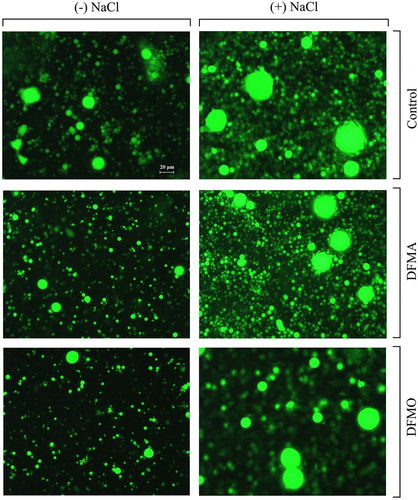Figures & data
Figure 1. Nile red staining of oil bodies (OBs). Fluorescence imaging of OBs isolated from cotyledons of 2-d-old, dark-grown seedlings, raised in the absence or presence of 120 mM NaCl, or nutrient medium supplemented with 500 µM of PA biosynthesis inhibitors, DFMA or DFMO, alone or in combination with 120 mM NaCl. OBs were incubated with Nile red stain and fluorescence from them (due to neutral lipids) was visualized (ex: 485 nm; em: 525 nm). Scale bar: 20 μm).

Figure 2. Expression aquaporins on OB membranes. Expression of proteins (A) and aquaporins [PIP2 (B); TIP1 and 2 (C, D)] in the OB membranes (bicarbonate washed) from 2-d-old, dark-grown sunflower seedling cotyledons, raised in the absence or presence of 120 mM NaCl, or PA biosynthetic inhibitors, DFMA and DFMO (500 µM of each), alone or in combination with 120 mM NaCl.
![Figure 2. Expression aquaporins on OB membranes. Expression of proteins (A) and aquaporins [PIP2 (B); TIP1 and 2 (C, D)] in the OB membranes (bicarbonate washed) from 2-d-old, dark-grown sunflower seedling cotyledons, raised in the absence or presence of 120 mM NaCl, or PA biosynthetic inhibitors, DFMA and DFMO (500 µM of each), alone or in combination with 120 mM NaCl.](/cms/asset/63d77077-98d6-4429-a88b-7d6ec7ad4794/kpsb_a_2217027_f0002_oc.jpg)
Figure 3. PA depletion causes a faster mobilization of OBs as observed from the retention of OBs of smaller diameter. A model is proposed summarizing present work wherein PA deficit results in 1) an enhanced oleosin degradation, 2) faster OB mobilization to facilitate TAG hydrolysis, 3) increased abundance of PIP2, and 4) differential regulation of TIPs suggesting a dynamic interaction of OBs with vacuoles and other organelles to facilitate the transport of water and glycerol, or maybe other molecules, required for OB hydrolysis. All of this together might support the seedling growth (5) in terms of root length previously observed by the authors.

